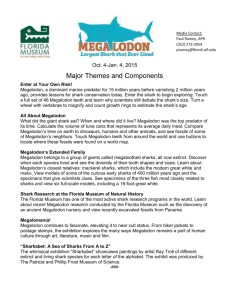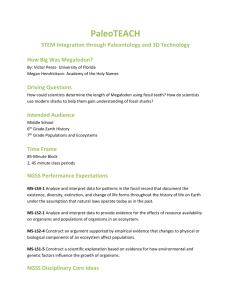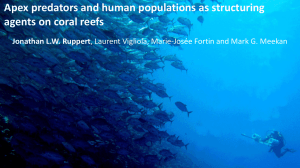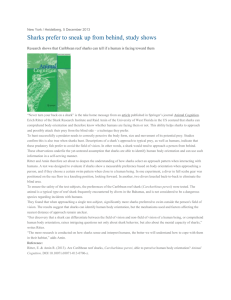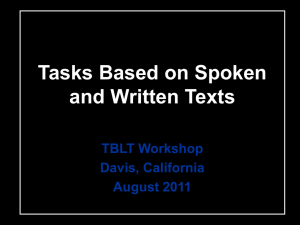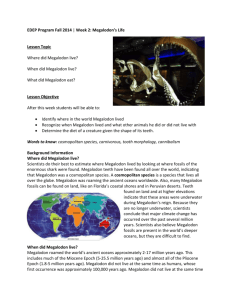EDEP Program Fall 2014 | Week 3: Why is Megalodon Important
advertisement
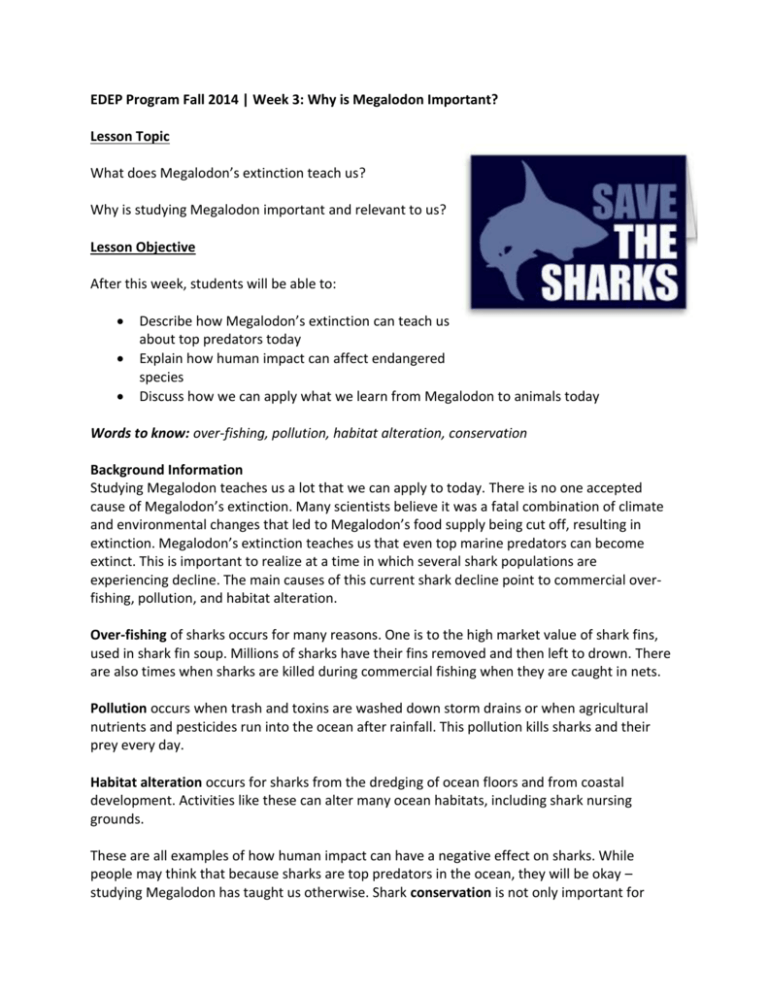
EDEP Program Fall 2014 | Week 3: Why is Megalodon Important? Lesson Topic What does Megalodon’s extinction teach us? Why is studying Megalodon important and relevant to us? Lesson Objective After this week, students will be able to: Describe how Megalodon’s extinction can teach us about top predators today Explain how human impact can affect endangered species Discuss how we can apply what we learn from Megalodon to animals today Words to know: over-fishing, pollution, habitat alteration, conservation Background Information Studying Megalodon teaches us a lot that we can apply to today. There is no one accepted cause of Megalodon’s extinction. Many scientists believe it was a fatal combination of climate and environmental changes that led to Megalodon’s food supply being cut off, resulting in extinction. Megalodon’s extinction teaches us that even top marine predators can become extinct. This is important to realize at a time in which several shark populations are experiencing decline. The main causes of this current shark decline point to commercial overfishing, pollution, and habitat alteration. Over-fishing of sharks occurs for many reasons. One is to the high market value of shark fins, used in shark fin soup. Millions of sharks have their fins removed and then left to drown. There are also times when sharks are killed during commercial fishing when they are caught in nets. Pollution occurs when trash and toxins are washed down storm drains or when agricultural nutrients and pesticides run into the ocean after rainfall. This pollution kills sharks and their prey every day. Habitat alteration occurs for sharks from the dredging of ocean floors and from coastal development. Activities like these can alter many ocean habitats, including shark nursing grounds. These are all examples of how human impact can have a negative effect on sharks. While people may think that because sharks are top predators in the ocean, they will be okay – studying Megalodon has taught us otherwise. Shark conservation is not only important for sharks, but other animals and plants in the ocean as well. For example, reef sharks are key to maintain coral reef ecosystems. This is because they consume many carnivorous fish, keeping their population down. When the carnivorous fish population is down, it allows the herbivorous fish population to increase. These herbivorous fish keep algae (which grow on corals) in check, allowing for healthy coral reefs. When the reef shark population declines, it has a huge impact on coral reef ecosystems and puts them at risk (see picture below). Activity Save the Sharks! About 35 minutes Objective Students will learn first-hand what it is like to be a top predator with your food dwindling – and then get an understanding of shark endangerment today and what’s causing it. Materials Field journals Open space Set of food cards, enough so there is one for each student Procedure Part 1: 1. Start this activity with a discussion with the students about reasons why they think Megalodon became extinct or how could something as big and dominant as it could go extinct. Megalodon ate whatever it wanted, how could it go extinct? Lead the students to realize that in Megalodon’s time, the Earth was a lot different than it is now (climate change, environmental change, etc.). Feel free to write their thoughts on a board or something of the like for everyone to see. Explain to the students that no one knows exactly what killed off Megalodon, but they are about to find out first-hand what scientists believe happened! 2. Move to an open space. Have all of the students turn around and face the wall or the outside of the circle, so their backs are pointed towards the open space in the center. Distribute the laminated food cards throughout the open space without letting the students turn around. Make sure that for this first round, there are enough cards so that each student can have one card. Explain to the students that they are all Megalodons, and the only way for them to survive is to prey on whales and other large fish. Tell them that in the center of the room, there are cards that represent whales and other large fish that Megalodon ate. In order to survive, each Megalodon must pick up to “eat” one food card. When all of the rules have been stated and understood, yell “Hunt!” and have the students turn around and hunt for food. 3. Once all the food cards are gone (each student should have one for this first round), ask the students what happened. Everyone got to eat, so all of the Megalodons survived. There is enough food, so they are surviving. 4. Have the students turn around to face the wall again and this time put less food items throughout the open space than there are students. Before you tell the students to hunt again, explain that there has been major climate change that may affect the Megalodons. Yell “Hunt!” again and let the students race to get food to survive! 5. Once all of the food has been eaten, pause the game. Have all of the Megalodons who did not get to eat sit down. Explain that these Megalodons died off due to starvation. Ask the students why they think there was less food this time. Explain that it was due to the climate changes. 6. Repeat steps 4-5 repeatedly, each time leaving less and less food. Give various explanations for why there may be less food items each time. Show the effects of other species disappearing by removing one species of food card and saying that the species has been hunted too much and that they are not available in the area anymore. Continue repeating steps 4-5 until there is no food left at all. 7. When there is no food left and all of the Megalodons have become extinct, sit the students back down and discuss what happened. Because of changes like extreme climate changes and overhunting, Megalodon’s food was unable to survive, so Megalodon did not survive. Discuss how scientists believe climate change occurred because Megalodon teeth have been found all over land, indicating that those regions used to be covered by water. The Ice Age may have had an impact on this as well. Part 2: 8. Transition into asking students why they think learning about Megalodon and its extinction is important. Lead the students to realize that Megalodon was a top predator, but still became extinct. This is important because many sharks today are endangered. If we are not careful, they can become extinct too. 9. Ask students why they think sharks are becoming endangered. Lead them to understand the words over-fishing, pollution, and habitat alteration and describe what these terms are and how/why they are occurring. Have the students write down definitions for these words and how they pertain to sharks. Discuss with students what can be done to limit this human impact that is having a negative effect on sharks. 10. Ask students why they think making sure shark populations are high is important. Lead them to realize that sharks play an important role in many marine ecosystems. Bring five chairs to the front of the room and ask tell them they are going to model the coral reef ecosystem. 11. Ask for five volunteers to come to the front of the room and sit in the chairs. Tell the class that the students represent the coral reef ecosystem, and (from left to right) the first student represents reef sharks, the second student is carnivorous fish, the third is herbivorous fish, the fourth is algae, and the fifth is coral. 12. Tell the students you will first represent a healthy ecosystem. In this there are a high number of reef sharks (have that student stand up) which results in a lower number of carnivorous fish (have this students sit on the ground), resulting in a higher number of herbivorous fish (have this student stand up), resulting in a lower number of algae that grows on the coral (have this student sit on the ground), resulting in a lot of healthy coral (have this student stand up). Explain these relationships as you tell them to sit or stand. Have students draw this model in their field journals using words or pictures with arrows up or down, representing high numbers and low numbers. Have them label it “Healthy Coral Reef Ecosystem.” 13. Now tell the students that reef sharks are endangered, so what happens to the ecosystem when these reef sharks experience population decline? Have the reef sharks sit on the ground, the carnivorous fish stand up, the herbivorous fish sit on the ground, the algae stand up, and coral sit on the ground. Explain these relationships as you tell them to sit or stand. Ask the students how the coral is doing now. Not well! That is why it is so important that we keep shark populations high and take action when sharks become endangered. Have the students draw out this scenario as well, labeling it “Coral Reef Ecosystem with Endangered Reef Sharks.” Glossary: Conservation: protection of valued resources: the preservation, management, and care of natural resources Habitat alteration (sharks): occurs due to the dredging of ocean floors and from coastal development. Activities like these can alter many ocean habitats, including shark nursing grounds. Over-fishing (sharks): occurs due to the high market value of shark fins, used in shark fin soup. Pollution: occurs when trash and toxins are washed down storm drains or when agricultural nutrients and pesticides run into the ocean after rainfall.

